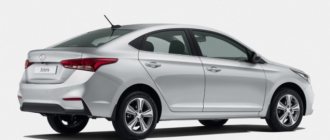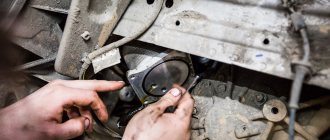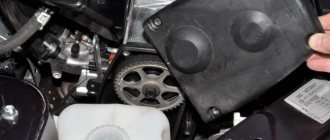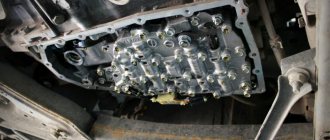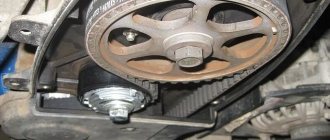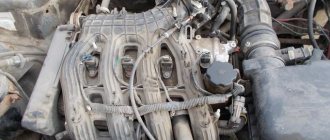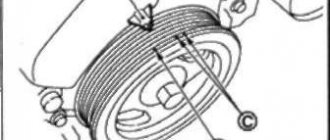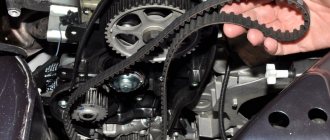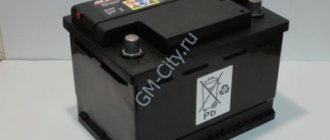Popular in the world and in Russia, in particular, the Nissan Qashqai crossover has been produced from 2006 to the present day. There are four varieties of this model: Nissan Qashqai J10 1st generation (09.2006-02.2010), Nissan Qashqai J10 1st generation restyling (03.2010-11.2013), Nissan Qashqai J11 2nd generation (11.2013-12.2019), Nissan Qashqai J11 2nd generation restyling (03.2017- present time). They are equipped with 1.2, 1.6, 2 liter petrol engines and 1.5 and 2 liter diesel engines. In terms of independent maintenance, this machine is quite complex, but with some experience you can handle it on your own. For example, change the timing belt yourself.
Design of the Qashqai 2.0 liter engine.
The in-line 4-cylinder 16-valve gasoline engine has an aluminum cylinder block. The timing chain drive is equipped with a variable valve timing system with a phase shifter on the intake camshaft. There are no hydraulic compensators in the cylinder head. The valves must be adjusted manually by selecting pushers-washers of different thicknesses.
Nissan Qashqai 2.0 engine cylinder head
The Nissan Qashqai block head is made of aluminum alloy. Two camshafts rotate in the bearing housing, which press their cams directly onto the valves through special pushers. The camshafts are not secured with separate covers, but with a common pastel. Spark plug wells have very thin walls; excessive force when tightening spark plugs leads to cracks in the cylinder head. The mechanism for changing the valve timing on the intake shaft is implemented using a hydraulic system. An increase in pressure causes an increase in the deviation of the camshaft from the nominal position relative to the valve axes. The oil pressure level is regulated by a solenoid valve controlled by the electronics of the Nissan Qashqai engine.
Exploitation
The power plants used in Nissan Qashqai cars, with proper maintenance, can “run” 500 thousand kilometers, and even this is not the limit. The manufacturer clearly indicates the basic rules for engine maintenance:
- Use recommended motor oils, taking into account the outside air temperature and the hydraulic characteristics of the lubricant. And although the manufacturer recommends changing the engine oil every 15,000 km, it is advisable to do this more often - after 7.5-10 thousand kilometers. This is due to the low quality of oils (there are many fakes on the market), which lose their performance properties faster than the engine manufacturer expects. Moreover, Nissan recommends changing the oil every 7,500 km under severe operating conditions.
- Use only certified coolants and change them every 60 thousand km. From time to time you need to check the coolant level in the tank and top it up if the level drops below the required level.
- Use gasoline with the octane number specified in the specifications. And although the use of AI-92 gasoline is allowed, it is advisable to fill the tank with AI-95 fuel of a reliable brand.
- Maintain the ignition system in good condition. If there are problems with starting, it is necessary to replace the spark plugs recommended by the manufacturer as soon as possible.
- Use oil filters recommended by Nissan. There is no need to choose a filter that only fits the thread. Air and gasoline filters should also be changed after completing the mileage specified in the documentation.
All these basic actions will significantly increase the service life of the motor, which is already long.
Timing drive of Nissan Qashqai 2.0 engine
Nissan Qashqai 2.0 timing chain drive . There are two chains. One larger one rotates the camshaft sprockets, the second a small one rotates the oil pump sprocket. With intensive use, the chain begins to stretch after 100,000 miles. This leads to phase shifts that even the automation that controls the phase shifter cannot correct. The timing diagram is further in the photo.
Engine characteristics Nissan Qashqai 2.0
- Working volume – 1997 cm3
- Number of cylinders – 4
- Number of valves – 16
- Cylinder diameter – 84 mm
- Piston stroke – 90 mm
- Timing drive - chain (DOHC)
- Power hp (kW) – 141 (104) at 6000 rpm. per minute
- Torque – 196 Nm at 4800 rpm. per minute
- Maximum speed – 195 km/h
- Acceleration to the first hundred – 10.1 seconds
- Fuel type – gasoline AI-95
- Fuel consumption in the city – 10.4 liters
- Fuel consumption in the combined cycle – 7.8 liters
- Fuel consumption on the highway – 6.3 liters
It is worth noting that in the first generation Qashqai, this engine showed a power of 141 hp. the second generation of the crossover with the same power unit shows a power of 144 horsepower.
Source
What do we end up with?
Actually, it is difficult to say which of the timing drives turns out to be more efficient in the end result. Perhaps this question is on a par with such rhetorical ones as: what is better - right-hand drive or left-hand drive, gasoline or diesel, manual or automatic.
Some users believe that the belt. Simply, making adjustments for its disadvantages, you need to carry out preventive maintenance more often, change it on time (or even at a predetermined date). Avoid contact with lubricant, protect as much as possible from the negative effects of the environment - and everything will be fine. On the other hand, the belt is trusted by manufacturers such as Volkswagen, Toyota and Opel. The belt is installed even on such advanced large V8 and V6 of these brands.
Well, among the fans of the “chain reaction” are BMW and Nissan
, which also cannot be trusted. So, to the question of what is better to install a timing chain or belt on a Nissan Qashqai, we did not find a clear and precise answer, so the easiest way is to trust the preference of the manufacturer. And this is for the 1.6 and 2.0 liter Kashak engines - still a chain.
Replacing the timing belt Nissan Qashqai
Popular in the world and in Russia, in particular, the Nissan Qashqai crossover has been produced from 2006 to the present day. There are four varieties of this model: Nissan Qashqai J10 1st generation (09.2006-02.2010), Nissan Qashqai J10 1st generation restyling (03.2010-11.2013), Nissan Qashqai J11 2nd generation (11.2013-12.2019), Nissan Qashqai J11 2nd generation restyling (03.2017- present time). They are equipped with 1.2, 1.6, 2 liter petrol engines and 1.5 and 2 liter diesel engines. In terms of independent maintenance, this machine is quite complex, but with some experience you can handle it on your own. For example, change the timing belt yourself.
Timing belt/chain replacement frequency for Nissan Qashqai
The recommended frequency of replacing a timing belt or chain on a Nissan Qashqai, taking into account Russian road realities, is 90 thousand kilometers. Or about once every three years. Moreover, the belt is more vulnerable to wear than the chain.
Periodically you need to check the condition of this element. If you miss the right moment, it threatens a sudden break of the belt (chain). This can happen at the wrong time, on the road, which can lead to a dangerous situation. Not to mention the fact that it will upset all plans and you will have to call a tow truck or contact a service station. And the cost of all these events is not cheap.
Which timing belts/chains to choose for Nissan Qashqai
The type of belt differs not by model - Nissan Qashqai J10 or J11, restyling or not - but depending on the engine type. In total, cars with four types of motors are sold in Russia, each with its own belt or chain:
- HR16DE (1.6) (petrol) – Nissan chain 130281KC0A; analogs – CGA 2-CHA110-RA, VPM 13028ET000, Pullman 3120A80X10;
- MR20DE (2.0) (petrol) – Nissan chain 13028CK80A; analogues – JAPAN CARS JC13028CK80A, RUPE RUEI2253, ASParts ASP2253;
- M9R (2.0) (diesel) – timing chain;
- K9K (1.5) (diesel) – timing belt.
It turns out that the belt is installed on only one version of the Qashqai engine - the 1.5 liter diesel. The price of analog spare parts is slightly lower than original ones. However, if you want to act reliably, it is probably better to overpay for the original.
Belt: pros and cons
- The belt is elastic and quiet, absorbs vibrations well from torsion, and does not require lubrication;
- Its faults can be easily diagnosed and eliminated without fundamental disassembly of the engine blocks. It can be changed according to the staffing schedule, when critical resource expenditure is still relatively far away.
The main disadvantage is vulnerability and dependence on external natural conditions, as well as technical ones: ingress of lubricant, for example.
If the belt breaks, the camshaft is no longer in sync with the crankshaft and the pistons hit the valves when they are open. Result: repair of engine compartment valves and many more troubles, including capital.
Checking status
The following signs indicate when to change the timing chain or belt:
- the motor generates an error due to the divergence of the phases of the gas distribution mechanism;
- The car starts with difficulty on a cold start;
- extraneous noises, knocking under the hood from the timing side during engine operation;
- the engine makes a strange metallic sound, which turns into a crackling sound when the speed increases;
- the engine pulls poorly and turns for a long time;
- fuel consumption has increased.
The car can also stop while moving. And when you try to start it again, it won’t work right away. Moreover, the starter will rotate easier than usual. A simple test will help determine wear: sharply press the gas pedal. At the same time, thick black smoke will come out of the exhaust pipe during acceleration.
If you remove the valve cover, chain wear can be seen with the naked eye. If it sags a lot in the upper part, then it’s time to change it. In general, computer diagnostics can give a hundred percent answer.
How to replace a mechanism chain
When working with the timing chain on a Nissan Qashqai 2L or other gasoline engines, done with your own hands, you must follow the following sequence of actions:
FUNCTIONAL PURPOSE OF THE TIMING BELT
Replacing the timing belt is part of routine maintenance on your Nissan Qashqai and plays an important role in the performance of the vehicle's engine. Untimely replacement of the belt can lead to a malfunction of the engine, and a break can lead to deformation of the gas distribution valve and the need for a major engine overhaul.
All parts of the gas distribution mechanism are closely connected to each other; the injection of the air-fuel mixture drives the piston of the engine cylinder, which in turn pushes the crankshaft, connected by a drive belt to the camshaft. Thus, the camshaft moves, which regulates the frequency of valve movement. The Nissan Qashqai timing belt connects the gears together and transmits torque from the crankshaft to the camshaft, affecting its rotation speed. If the system is working properly, their speed should be equal.
TYPES OF TIMING BELT FAULTS
- Wear of the timing belt leads to a change in the torque transmission force from the crankshaft to the camshaft, resulting in a change in the frequency of movement of the engine pistons and valves. This, in turn, leads to a malfunction of the gas distribution system, rapid heating of the engine and, as a consequence, a decrease in engine power and an increase in consumption of the fuel mixture. For reliable and uninterrupted operation of the engine, it is necessary that the valves close and open at the same frequency as the engine pistons. If the timing belt slips due to wear, it can cause a break.
- A broken Nissan Qashqai timing belt is the most dangerous damage to the engine. If such a malfunction occurs, the camshaft ceases to be connected to the crankshaft and can stop completely arbitrarily in a position in which any of the valves of the gas distribution mechanism is open. In this case, the piston, moving upward, may collide with the valve, which will lead to its deformation. In this case, the car engine faces serious repairs. It should be noted that a timing belt break does not occur unexpectedly; it is almost always accompanied by changes in the operation of the car engine, a decrease in its power, a change in gasoline consumption, the appearance of extraneous squeaks, creaks, etc.
To prevent and prevent the operation of the gas distribution mechanism, it is necessary to periodically replace the timing belt; this will save the Nissan Qashqai engine from breakdown, prevent premature engine wear and increase its service life.
CAUSES AND ASSESSMENT OF TIMING BELT WEAR
Timing belt wear occurs for a number of reasons, avoiding which can extend the life of the car engine.
To prevent complete wear of the timing belt, it is necessary to periodically, during a visual inspection of the gas distribution mechanism, check for damage to the surface of the belt. To inspect and evaluate the belt drive, it is necessary to unscrew and remove the protective casing of the mechanism under which the engine is hidden. The first signs of wear are:
- the appearance of oil and antifreeze smudges capable of chemically destroying the timing belt, with prolonged exposure;
- the occurrence of longitudinal cracks on the rear surface of the belt;
- formation of transverse cracks on the inner surface of the drive belt;
- a torn surface and a broken edge are also signs of wear;
- Rubber dust on the surface of the part also indicates belt wear;
- If the timing belt teeth begin to peel off or wear off, the part must be immediately replaced with a new one.
SIGNS OF A FAULTY TIMING BELT
- Gasoline consumption by car has increased
- Engine power has decreased
- A complete stop of the car while moving; when you try to start, the engine does not start, and the starter rotates more easily than usual
- Unstable engine operation at idle and while driving;
- The occurrence of shots in the injector receiver and exhaust pipe
All these problems may indicate a shift in the valve timing and loosening of the belt tension. If you notice one or more signs from this list on your Nissan Qashqai, immediately contact a service station for an inspection.
HOW OFTEN IS IT NEEDED TO REPLACE THE TIMING BELT FOR A Nissan Qashqai
The frequency of replacing any consumables for cars depends on the driving style and operating mode of the car. In case of extreme driving style and aggressive use of the vehicle, it is necessary to replace the timing belt as it wears out and the teeth wear out.
Under normal operating conditions, it is necessary to replace the original timing belt as planned, every 60 - 70,000 km. mileage During this period, it exhausts its resource and becomes unusable. If your Nissan Qashqai is equipped with an analog belt, replacement must be made a little earlier than the time recommended by the vehicle manufacturer.
WHICH TIMING BELT IS BETTER TO CHOOSE
Modern belts for the gas distribution system are a high-tech product, characterized by increased strength and wear resistance, capable of withstanding high dynamic loads. Timing belts are made from neoprene or polychloroprene with reinforcement with strong cord threads made of fiberglass, nylon and cotton.
- To avoid the mistake associated with purchasing a timing belt, contact specialists who will help you, using your car’s WIN code, order a timing belt suitable for your car’s engine. This part is one of the most important in the engine design; the slightest deviation in the length, width, shape and size of the teeth can lead to problems with the Nissan Qashqai engine.
- Do not try to save money when buying a timing belt; a cheap product may be a low-quality fake that will quickly become unusable and in the future may cause serious engine damage. The best option for any car is original parts; their cost is higher than analogue ones, but when using the car they quickly pay for themselves.
- When purchasing a timing belt, check its rigidity; a good belt should be elastic and bend easily. The worse the belt, the stiffer it will be.
- The presence of teeth, sagging, or pores on the belt is not allowed - these are signs of a low-quality belt that will quickly become unusable. The surface of the product must be smooth, small burrs are allowed.
- When purchasing it yourself, check the timing belt part number printed on the back side; it must correspond to the WIN code of the car. If it is not possible to compare the code of the belt and the car, then it is necessary to make a visual comparison of the old and new belt; they must be completely identical.
- To avoid buying counterfeits, try to purchase spare parts only from official, trusted dealers.
- Don’t skimp on a qualified timing belt replacement; contact our certified auto service center, where competent mechanics will help you repair your Nissan Qashqai. And in the spare parts store you can buy original spare parts for your car.
Nissan Qashqai is equipped with petrol engines HR16DE (1.6), MR20DE (2.0) and diesel units M9R (2.0), K9K (1.5). On gasoline engines, regardless of the type of engine, the movement of the camshaft is driven by a chain drive. On diesel engines, the timing chain is only installed on the M9R (2.0).
According to the Qashqai technical data sheet, the procedure for replacing the timing chain. See the photo report to see how to cope with replacing the chain yourself.
Necessary tools and spare parts, consumables
To change the timing chain with your own hands, you will need:
- ratchet with extension;
- socket heads for 6, 8, 10, 13, 16, 19;
- regular flat screwdriver;
- automotive sealant;
- fixture KV10111100;
- puller KV111030000;
- jack;
- container for draining engine oil;
- special puller for the crankshaft pulley;
- knife.
You will also need gloves, work clothes, rags and, in fact, a new replacement timing chain. It is better to do everything on a viewing hole or a lift.
Instructions
How to replace the timing chain with your own hands on 1.6 and 2.0 engines:
- Drive the car onto a pit or lift. Remove the right wheel.
- Unscrew and remove the engine cover. Remove the exhaust manifold.
- Drain all engine oil from the engine.
- Unscrew the bolts and remove the cylinder head cover.
- Rotate the crankshaft and place the number one cylinder piston in the TDC compression position.
- Raise the power unit with a jack. Unscrew and pull out the engine suspension support on the right side.
- Remove the alternator belt.
- Using a special puller, holding the crankshaft pulley from turning, unscrew its mounting bolts by 10-15 mm.
- Using puller KV111030000, pull the pulley off the crankshaft. Completely unscrew the pulley mount and remove the roller.
- Unscrew and pull out the suspension belt tensioner.
- Disconnect the harness connector from the variable valve timing system valve.
- Pull out the solenoid valve, having first unscrewed the bolt on which it is attached.
- This allows access to the side cover of the engine, under which the timing chain is located. Using a ratchet and sockets, remove the bolts securing this cover. Cut the sealing seam with a knife and remove the cover.
- Press out and fix the tensioner using for this purpose a one and a half millimeter rod inserted into the hole. Unscrew the bolt located on top with the bushing on which the chain guide is attached, and remove the guide itself. Do the same with the second guide.
- Now, finally, you can pull out the timing chain. To do this, you need to remove it first from the crankshaft sprocket, and then from the pulleys. If the fastening of the tensioner interferes, then remove it too.
- After that, it's time to start installing the new chain. The procedure is the reverse of that for removal. It is important to match the marks on the chain with the marks on the pulleys.
- Carefully remove any remaining sealant from the joints of the cylinder block and timing cover. Then carefully apply fresh sealant, trying not to exceed a thickness of more than 3.4-4.4 mm.
- Replace the timing cover and tighten the bolts. Install the remaining parts in the reverse order of dismantling.
Engine design Qashqai 1.6
The Qashqai HR16 engine is 1.6 liter, it is a petrol 4-cylinder 16 valve unit. The in-line engine has an aluminum cylinder block with so-called “wet liners”. The cylinder head does not have hydraulic compensators. The thermal clearance of the valves is adjusted by selecting pushers of different thicknesses. Two camshafts are located in the cylinder head bearing housing. The timing drive uses a chain. For better fuel efficiency, two injectors per cylinder are used. Electronically controlled fuel injection. An actuator for the variable valve timing system is installed on the intake shaft.
Nissan Qashqai 1.6 engine cylinder head
The Nissan Qashqai cylinder head is made of aluminum alloy. An actuator for changing valve timing (phase shifter) is installed on the intake camshaft. The phase regulator mounted on the intake camshaft is controlled by increasing the engine oil pressure from the drive system. An increase in pressure causes an increase in the deviation of the camshaft from the nominal position relative to the valve axes. The oil pressure level is regulated by a solenoid valve controlled by the electronics of the Nissan Qashqai engine.
Oil pump Qashqai 1.6
The oil pump is located in the sump. The pump has its own separate chain drive from the crankshaft sprocket, due to which the torque is transmitted to the pump sprocket.
Engines for second generation cars
The second generation Nissans used improved MR20DE internal combustion engines. They received the name MR20DD (that is, only the last letter was changed). During the improvement, the engine was supplemented with a variable valve timing system on two shafts, and an intake manifold with direct injection and variable length was added. This made it possible to increase power to 144 hp. s., torque - up to 200 Nm. This is the maximum torque achieved at a rotation speed of 4400 rpm.
At the same time, the engine remained economical - its consumption was 5-8.5 liters per 100 km. In addition to the Nissan Qashqai, the installation was installed on other cars:
- Minivans 4-5 generations (Serena).
- 3rd generation SUVs - X-Trail.
Now this engine is installed on restyled Nissan Qashqai models.
Another gasoline engine installed on second-generation Nissans is the H5FT with a power of 115 hp. With. and a cylinder volume of 1.2 liters.
The maximum torque (205 Nm) is achieved at 2000 rpm, which allows you to “rip” at the start and quickly develop high speeds. This is an extremely economical internal combustion engine with consumption of 5.6-6.2 liters per 100 km. The small volume of the cylinders is compensated by the presence of a supercharger (turbine). The engine itself received a timing chain, an aluminum cylinder block (to reduce weight), direct injection and a variable valve timing system.
A special feature of this internal combustion engine is a supercharger with a low cylinder volume. Therefore, after the start, in order to confidently switch to second gear, it must be revved up to 4000 rpm. This moment is extremely unpleasant for many owners, but you can get used to it.
The latest engine installed on the 2nd generation Nissan Qashqai is the R9M with a volume of 1.6 liters. This is a diesel power plant with a supercharger with a capacity of 130-160 hp. With. and a torque of 380 Nm (at 1750 rpm).
The engine is also installed on Renault cars. Like many other Nissan power plants, it uses a timing chain (the chain is designed to last the entire service life of the engine, although it stretches after 300 thousand kilometers). The variable geometry turbine provides an additional 1.5 bar of boost, which provides the specified power.
The engine does not have serious shortcomings or miscalculations, but there are minor shortcomings. One of the common problems is contamination of the return valve, which jams the injectors and makes it difficult to remove them.
The turbine and liners are reliable - they last about 300 thousand kilometers, but the EGR valve will have to be cleaned every year, otherwise the accumulated carbon will jam it, and then the air-fuel mixture supplied to the cylinders will receive the wrong proportion. With normal maintenance, the engine will last a long time - it is an excellent diesel engine, which in many cars runs over 350-400 thousand km. In addition, it can be tuned, which allows you to add about 30 hp. With.
Timing drive for Nissan Qashqai 1.6 engine
Qashqai timing chain drive . There are two chains. One larger one rotates the camshaft sprockets, the second a small one rotates the oil pump sprocket. The timing diagram is further in the photo.
Characteristics of the Qashqai 1.6 engine
- Working volume – 1598 cm3
- Number of cylinders – 4
- Number of valves – 16
- Cylinder diameter – 78 mm
- Piston stroke – 83.6 mm
- Timing drive - chain (DOHC)
- Power hp (kW) – 114 (84) at 6000 rpm. per minute
- Torque – 156 Nm at 4000 rpm. per minute
- Maximum speed – 178 km/h
- Acceleration to the first hundred – 11.8 seconds
- Fuel type – gasoline AI-92
- Fuel consumption in the city – 8.3 liters
- Fuel consumption in the combined cycle – 6.6 liters
- Fuel consumption on the highway – 5.6 liters
Does the Qashqai have a chain or a timing belt?
The design of the timing drive on the Nissan Qashqai differs depending on the type of engine. Almost all Qashqais are equipped with a timing chain. The only exception is a car with a 1.5 liter K9K engine. This engine has a belt installed.
There are advantages and disadvantages in both cases. The most obvious advantage of a timing chain drive is its durability. The disadvantage is that it is noisier. But on the Nissan Qashqai, this problem is solved with the help of sound insulation. The timing belt is more elastic, cheaper and easier to replace, but has a shorter service life and the risk of rupture.
Since the most popular cars are those with a timing chain, we will consider what catalog numbers of the original spare part and its analogues it may have.
Chain: pros and cons
The main argument for fans of chain drive is its durability. In fact, if the belt is designed for 40-60 thousand car mileage, then the chain can go 300 without problems (you just need to monitor it and tighten it periodically). This is probably why the Japanese, who traditionally value longevity and strength, install mainly a chain on the Nissan Qashqai.
Timing chain Nissan Qashqai 1.6
On Qashqai cars with 1.6 liter engines, a chain is installed under article number 130281KC0A . Manufacturer: Nissan. Average price – 5800 rub. Also, when replacing the timing chain, the following parts are changed along the way: damper - article number 130911HC0A , part price - 1600 rubles, and tensioner - 130701KT0A , price - 2300 rubles.
The timing chain is located on the side of the engine, under a special protective cover.
The most popular analogues of the original timing chain for Nissan Qashqai 1.6 l:
2-CHA110-RA . Manufacturer: CGA. The average price of a spare part is 2800 rubles. The main advantage of this model is its lower price than the original;
13028ET000 . Manufacturer: VPM. Average price - 1400 rubles. Like the previous model, this substitute has a price on average 3 times lower than the original. There are no significant differences in the quality of this part from the original.
Timing chain Nissan Qashqai 2.0
For Nissan Qashqai with a gasoline engine MR20DE (2.0 l.), the manufacturer installs a timing chain under the article number 13028CK80A . Price – 6300 rub. The supplier of the part is Nissan. There is no exact information about the manufacturer and direct analogues yet. According to unofficial information, the manufacturer is JAPAN CARS, and the direct analogue is JC13028CK80A . Price – 4700 rub.
As on the previous engine model, when replacing the timing chain, they change the damper - article number 13091EN200 , the price of the part is 2100 rubles, and the tensioner - 11955JD21A , the price is 3200 rubles.
You can also pay attention to the popular timing chain analogues for Qashqai 2.0:
ASP2253 . Manufacturer: ASParts. Average price - 1400 rubles. The model has good reviews, and is often installed instead of the original, as a cheaper substitute;
RUEI2253 . Manufacturer: RUEI. Price – 1300 rub. Also a good analogue of the original spare part. A good combination in the price/quality category.
Create an account
Register for an account. It's simple!
Already registered? Sign in here.
Related publications
Merry Christmas everyone. The Qashqai hra2ddt (1.2 115hp) began to stall, and noise appeared in the timing belt area. During diagnostics, errors P0030 and P0017 appeared. They opened the windshield, the tensioner got damaged, and the chain jumped over the teeth. There were too many marks on the shafts for me to install a new chain. There is zero information on this engine on the Internet, I ask for help while the engine is opened and it’s a holiday. What marks should I put the chain on?
There are currently 0 users on the page
There are no users viewing this page
